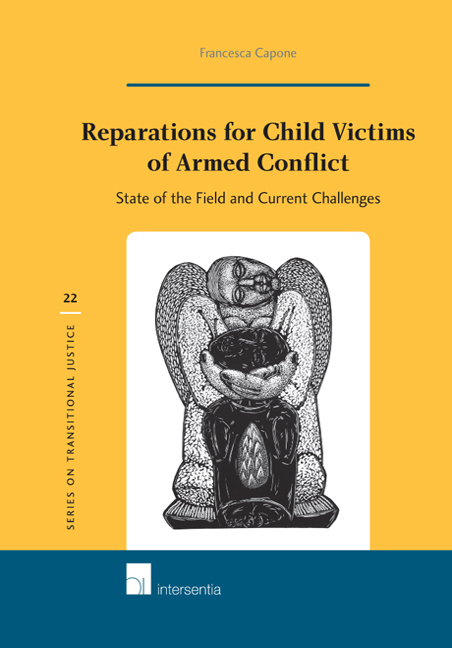Book contents
- Frontmatter
- Dedication
- Foreword
- About the Author
- Acknowledgements
- Contents
- Table of Cases
- Table of International Instruments
- List of Abbreviations
- Chapter 1 Setting the Scene
- PART I THE NORMATIVE AND THEORETICAL FRAMEWORK
- PART II CURRENT APPLICATION OF THE PRINCIPLES AND NORMS
- Chapter 5 Child Victims’ Right to Reparation in ‘Quasi-Judicial’ and Judicial International Settings
- Chapter 6 Child Victims’ Right to Reparation in ‘Quasi-Judicial’ and Judicial Regional Settings
- Chapter 7 Child Victims’ Right to Reparation in Non-Judicial Settings
- Chapter 8 Final Remarks
- Bibliography
- Index
Chapter 7 - Child Victims’ Right to Reparation in Non-Judicial Settings
from PART II - CURRENT APPLICATION OF THE PRINCIPLES AND NORMS
Published online by Cambridge University Press: 29 September 2018
- Frontmatter
- Dedication
- Foreword
- About the Author
- Acknowledgements
- Contents
- Table of Cases
- Table of International Instruments
- List of Abbreviations
- Chapter 1 Setting the Scene
- PART I THE NORMATIVE AND THEORETICAL FRAMEWORK
- PART II CURRENT APPLICATION OF THE PRINCIPLES AND NORMS
- Chapter 5 Child Victims’ Right to Reparation in ‘Quasi-Judicial’ and Judicial International Settings
- Chapter 6 Child Victims’ Right to Reparation in ‘Quasi-Judicial’ and Judicial Regional Settings
- Chapter 7 Child Victims’ Right to Reparation in Non-Judicial Settings
- Chapter 8 Final Remarks
- Bibliography
- Index
Summary
INTRODUCTION
Quasi-judicial as well as judicial mechanisms, boThat the regional and at the international level, consider reparations as a strictly legal concept subject to legal rules and procedures. Consequently, victims are necessarily identified wiThthose who have suffered direct or indirect harm as a result of acts or omissions that amount to a violation of international law. In non-judicial settings, however, the identification of the beneficiaries of reparative measures is much more flexible and in some instances it may even coincide wiThthe affected population as a whole. There are a number of non-judicial mechanisms which have dealt wiThthe issue of reparations for child victims of armed conflict. These are TCs, national reparations programmes, the ICC, TFV, and DDR processes. Such mechanisms pursue the twofold aim of providing victims wiThwide-ranging redress measures and fostering peace, security and reconciliation ‘through a heartfelt and public commitment to human rights’. In many cases national reparations programmes are contingent on, or stem from, the work of TCs. As noted by de Greiff, ‘there seems to be a trend towards establishing TCs in post-conflict societies and societies in transition and entrusting them wiThmaking recommendations concerning reparations’. However, not all national reparations programmes rely on the findings of a TC, not all post-conflict countries have established the same mechanisms to come to terms wiThtheir past and not all mechanisms have equally taken into account child victims.
TRUThCOMMISSIONS
According to Teitel a TC can be described as ‘an official body, often created by a national government, to investigate, document, and report upon human rights abuses within a country over a specified period of time’. The general aim of a TC is to provide a comprehensive record and analysis of the violations committed during an armed conflict or a military dictatorship. From 1974 to 2007 at least 32 TCs were established in 28 countries worldwide and, according to Heyner, by 2011 their number had increased to 40.
- Type
- Chapter
- Information
- Reparations for Child Victims of Armed ConflictState of the Field and Current Challenges, pp. 209 - 240Publisher: IntersentiaPrint publication year: 2017



